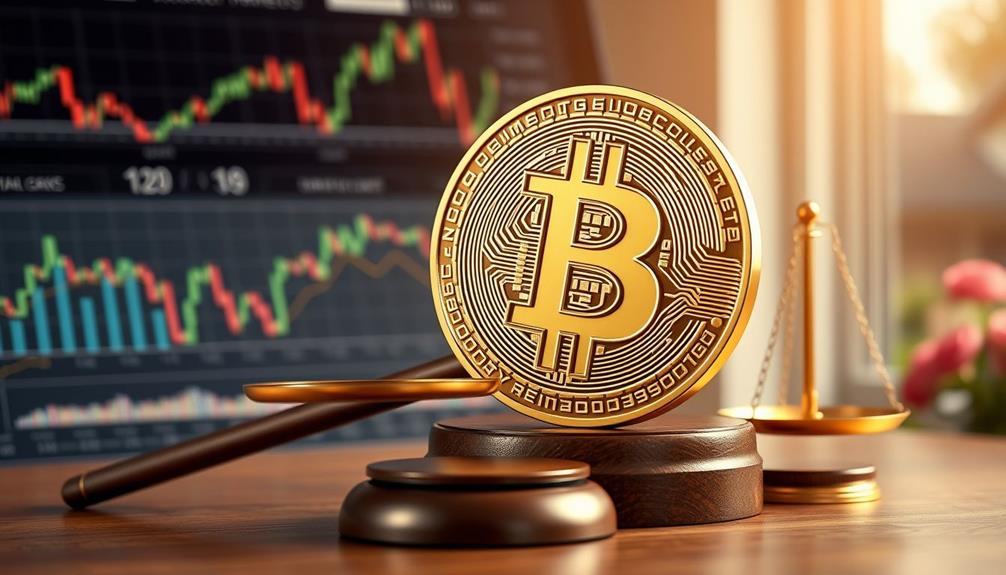Ripple's regulatory situation is tense, teetering on the edge of a major shift. The SEC lawsuit against Ripple claims they've sold unregulated securities, creating a significant vacuum in market confidence. A recent court ruling declared XRP isn't a security for retail sales but noted severe penalties for institutional transactions. This leaves you wondering how Ripple's future will shape up amid strict regulations and market volatility. The outcome of this legal battle could redefine the entire crypto landscape and your investments. Stay tuned to uncover more about what this means for you and the financial order.
Key Takeaways
- Ripple's ongoing SEC lawsuit highlights the fragility of regulatory frameworks and their potential to disrupt the entire cryptocurrency market.
- A shift in regulatory clarity, especially with new SEC leadership, could redefine Ripple's operations and impact the broader financial order.
- The complexity of overlapping jurisdictions among regulatory bodies creates uncertainty, risking significant market volatility and investor confidence in cryptocurrencies.
- Ripple's compliance challenges and penalties reflect the larger trend of stringent regulations in the crypto sector, potentially destabilizing existing financial systems.
- The introduction of innovative financial products like stablecoins underscores the urgent need for clear regulatory guidelines to prevent systemic disruptions.
Overview of the SEC Lawsuit

The SEC lawsuit against Ripple has become a significant case in the cryptocurrency landscape, raising vital questions about the regulatory status of digital assets. You might find it surprising that the SEC charged Ripple and its executives, Brad Garlinghouse and Christian Larsen, with selling unregulated securities valued at over $1.3 billion through the XRP token.
The SEC alleged that Ripple failed to file a registration document, which is essential for raising capital from the public. They claimed Ripple created an "information vacuum," sharing selective details with investors.
In July 2023, a federal court ruled that while XRP tokens aren't securities when sold to retail investors, institutional sales were deemed unregistered securities offerings. Ripple faced a penalty of $125 million due to improper sales to institutional investors, but the court denied the SEC's request for Ripple to surrender over $876 million in profits. Additionally, the SEC's appeal following this ruling may significantly impact the future of XRP as an asset.
The ruling also included a permanent injunction, preventing further violations of securities laws. As the SEC appeals this decision, the implications for Ripple and the broader cryptocurrency market continue to unfold, keeping you on the edge of your seat.
The Regulatory Gray Area

While traversing the cryptocurrency landscape, you'll quickly realize it exists within a regulatory gray area that complicates compliance for businesses and consumers alike. Multiple federal and state agencies, including the SEC, CFTC, and FDIC, have overlapping jurisdictions, leading to inconsistencies and confusion. This fragmentation makes it challenging for Fintechs to navigate the rules, often leaving them uncertain about compliance.
The existing regulatory framework is slowly adapting to the unique attributes of cryptocurrencies, but opinions vary. Ripple believes that with some adjustments, the current framework can provide necessary clarity and protection. In contrast, Coinbase argues for a new dedicated regulator, emphasizing that the existing rules aren't sufficient. Ripple advocates for the Digital Commodity Exchange Act as a way to improve regulatory clarity.
Regulators are increasingly focused on protecting consumers and investors from risks like fraud, cyber threats, and market volatility. The enforcement environment is complex, with multiple agencies actively pursuing enforcement actions, which adds to the uncertainty businesses face.
Amid this confusion, public-private collaboration is essential. Ripple proposes a working group involving industry representatives and regulatory bodies to foster clearer communication and innovation, ultimately aiming for a more effective policy framework that benefits everyone involved.
Ripple's Market Impact

Maneuvering the regulatory gray area has significant implications for Ripple's market impact, particularly concerning XRP's value and adoption. The ongoing SEC lawsuit creates a volatile environment, where XRP's price fluctuates dramatically based on case developments. Regulatory uncertainty undermines investor confidence, yet a favorable outcome could lead to substantial growth in XRP's value.
Here are three key factors influencing Ripple's market impact:
- Cross-Border Payment Efficiency: Ripple's technology revolutionizes cross-border transactions, enhancing speed and lowering costs. As more financial institutions adopt RippleNet, the demand for XRP as a bridge currency may rise.
- Investor Sentiment: Market sentiment plays an essential role; anticipation around court rulings drives price movements. A positive ruling could boost investor confidence and market stability, especially if the SEC decides to dismiss its case against Ripple due to Gensler's potential departure.
- Adoption Rates: The integration of Ripple's solutions into existing banking systems is important. Partnerships with global financial institutions are significant for increasing XRP's usage and establishing its role in the broader financial ecosystem.
Navigating regulatory challenges is imperative for Ripple. Successful adaptation could reveal substantial potential, reshaping how money moves in a digital age.
Financial Penalties and Consequences

As you explore Ripple's financial penalties and consequences, it's essential to understand how these fines can impact market dynamics and the company's financial strategies.
The recent $125 million penalty from the SEC, while less than anticipated, still sends ripples through the crypto landscape. This ruling specifically relates to institutional sales of XRP, which were deemed unregistered securities, highlighting the ongoing regulatory scrutiny Ripple faces.
You'll see how Ripple navigates these challenges and adapts its approach in response to ongoing regulatory pressures.
Potential Financial Penalties
Ripple's recent legal battles highlight the harsh financial penalties that can arise from regulatory violations in the crypto space.
You see, Ripple was ordered to pay $125.035 million in civil penalties, a figure that's considerably lower than the SEC's initial demands. This fine arose from 1,278 institutional sales of XRP, which breached securities regulations. The ruling has set a legal precedent for cryptocurrency regulation, impacting future cases in the industry. Additionally, the average time to mine Bitcoin can underscore the significant costs associated with regulatory compliance in the crypto mining sector.
The repercussions could extend further, especially since the SEC is likely to appeal the ruling on retail sales.
Here are three key takeaways on potential financial penalties in the crypto world:
- Heavy Fines: The SEC imposed $4.68 billion in fines across crypto companies in 2024 alone, showcasing a trend toward aggressive enforcement.
- Historical Context: Ripple's fine pales in comparison to Terraform Labs' staggering $4.68 billion penalty, highlighting the SEC's focus on high-profile cases.
- Broader Implications: Non-compliance can lead to severe outcomes, including loss of trust, operational disruptions, and even criminal penalties in extreme situations.
These factors underscore the critical importance of staying compliant in today's rapidly evolving regulatory landscape.
Market Reaction Dynamics
The financial penalties imposed on Ripple haven't only impacted the company directly but also triggered notable reactions in the broader market. After the court ordered Ripple to pay $125 million, considerably lower than the SEC's demands, XRP's price saw a slight uptick of about 2%.
However, this brief positivity was overshadowed by overall market volatility. Just a month earlier, XRP had plummeted nearly 34% due to broader crypto market fluctuations and geopolitical concerns.
You might also notice increased selling pressure from Ripple's release of around one billion XRP tokens, which exacerbated the situation. Additionally, XRP's performance closely mirrored that of Bitcoin, meaning any drop in BTC's price pulled XRP down with it.
The SEC's impending appeal and the judge's injunction against future violations raise further uncertainty. With Ripple required to file a registration statement for any future sales of securities, the company must navigate a complex regulatory landscape. As Ripple's XRP Ledger continues to process transactions in seconds, the outcome of the legal battles could significantly impact its operational capabilities.
All these factors combined create a ripple effect in market dynamics, making it essential for investors to stay informed and prepared for ongoing changes.
Ripple's Financial Strategies
Steering through financial penalties and regulatory scrutiny, Ripple faces significant challenges that could reshape its operational landscape. Recently, a civil penalty of $125.035 million was imposed by District Judge Analisa Torres, a figure significantly less than what the SEC initially sought. This ruling highlights Ripple's need to maneuver complex regulations while maintaining its business model. The judgement allows cryptocurrency trades on exchanges to not be classified as securities, which is crucial for Ripple's operational strategy.
Here are three key financial strategies Ripple must consider:
- Compliance with Securities Laws: Ripple must guarantee all future XRP sales adhere strictly to securities regulations to avoid further penalties.
- Registration Requirements: Any new crypto asset introduced by Ripple will require a registration statement, increasing operational overhead but guaranteeing legal compliance.
- Injunction Adherence: Ripple is now under an injunction that prohibits future violations of securities laws, which places limitations on its business strategies and growth potential.
These financial penalties and consequences illustrate the precarious balance Ripple must maintain as it aims for innovation while fulfilling regulatory obligations.
The company's long-term vision relies heavily on successfully maneuvering this challenging landscape without compromising its mission of creating an Internet of Value.
Future Developments and Innovations

Often at the forefront of innovation in the cryptocurrency space, XRP is poised for significant future developments that could reshape its role in the digital economy.
The recent court ruling, which determined that XRP isn't considered a security when traded on public exchanges, boosts market confidence and sets a precedent for digital asset regulation in the U.S. This clarity will likely foster further institutional interest, including ETF proposals from firms like Bitwise Asset Management. Additionally, XRP has recorded a recent price surge that reflects strong investor interest and activity, further enhancing its market position.
XRP continues to expand its use cases, particularly in cross-border payments and the burgeoning DeFi sector. Ripple is actively promoting the XRPL ecosystem, encouraging innovative applications that leverage XRP's capabilities.
Additionally, the anticipated launch of the RLUSD stablecoin under a limited purpose trust charter will solidify XRP's position in the regulated U.S. crypto market, offering a stable alternative for cross-border transactions.
As XRP's price surges and its market capitalization approaches $139 billion, the future looks bright. With growing institutional engagement and innovative product launches, XRP is set to play a vital role in the evolving landscape of the digital economy.
Navigating Compliance Challenges

Steering compliance challenges can feel overwhelming, especially with the global regulatory landscape constantly shifting. You'll need to develop a robust compliance strategy that adapts to varied regulations across different jurisdictions. Understanding these complexities is essential for successfully positioning Ripple in the competitive crypto market. The anticipated launch of RLUSD, a stablecoin pegged to the U.S. dollar, highlights the importance of regulatory compliance in gaining credibility within the industry.
Global Regulatory Variability
As you explore the complexities of global regulatory variability, you'll quickly realize that maneuvering compliance challenges requires a keen understanding of diverse jurisdictional landscapes.
Regulations can differ considerably between countries and regions, which can create major hurdles for financial institutions. Here are three key factors to take into account:
- Jurisdictional Differences: You'll need to comply with various regulations, like the U.S. Dodd-Frank and EU MiFID II, making it essential to stay informed on each jurisdiction's rules.
- Cultural Values: Be aware that cultural norms influence how regulations are perceived. This can lead to misunderstandings and compliance issues in international operations.
- Data Protection Laws: Each country has its own data privacy regulations. You'll face a complex web of laws that demand a nuanced understanding to guarantee compliance. Additionally, the increased focus on cybersecurity means that financial institutions must be vigilant about evolving threats and regulatory standards.
Navigating these challenges isn't just about understanding the rules; it's also about adapting your strategies to local norms and practices.
The cost of regulatory divergence can be steep, often hindering expansion into new markets. By recognizing these variabilities, you can better position your organization to thrive in a global landscape.
Compliance Strategy Development
In light of the complexities brought on by global regulatory variability, developing a robust compliance strategy is vital for organizations operating in multiple jurisdictions. You need to adapt continuously to rapidly evolving regulations driven by technological advancements and societal expectations. This requires a proactive approach to regulatory monitoring. Regulatory compliance is essential for ensuring integrity, transparency, and stability in financial systems.
Implementing internal controls is essential. Well-documented policies guarantee consistency in compliance, while robust safeguards prevent violations. Regular reviews of contracts can help maintain compliance as well.
Leveraging regulatory technology (RegTech) can streamline your compliance management. Advanced data analytics can detect anomalies, while machine-learning tools enhance transaction monitoring accuracy. Here's a succinct breakdown of key elements:
| Compliance Element | Purpose |
|---|---|
| Internal Controls | Prevent, detect, and correct violations |
| Regulatory Monitoring | Stay informed about new and updated regulations |
| RegTech Implementation | Automate tasks and enhance accuracy |
Defining clear compliance strategy goals aligned with your organization's objectives will help you prioritize your efforts. Conduct regular risk assessments to set measurable targets, encouraging a culture of compliance throughout your organization.
The Role of Regulatory Clarity

Regulatory clarity serves as the bedrock for a stable and thriving crypto market, bridging the gap between innovation and compliance.
Without a thorough legal foundation, the crypto landscape remains unpredictable, risking capital flows and market stability.
Here's why regulatory clarity is essential:
- Consistent Regulations: Following the principle of "same activity, same risk, same regulation" helps guarantee that crypto is treated fairly across jurisdictions. This consistency minimizes confusion and fosters trust among users and investors, especially in light of the urgent need for investor protection.
- Consumer Protection: Clear regulations protect consumers from misleading practices and enhance transparency. By implementing strong anti-money laundering and combating the financing of terrorism (AML/CFT) rules, you can create a safer environment in the financial market.
- Alignment with International Standards: National authorities must align their frameworks with guidelines from standard-setting bodies like the Financial Stability Board (FSB). This global coordination promotes uniform regulation, reducing discrepancies that can destabilize the market.
Potential Changes in Leadership

The recent resignation of SEC Chair Gary Gensler marks a significant turning point for the cryptocurrency landscape, particularly for Ripple and XRP. With Gensler's aggressive regulatory stance now a thing of the past, you can expect a shift in the regulatory environment that could benefit the crypto market. The optimism surrounding this change, especially with a pro-crypto President-elect coming into office, has already led to a surge in XRP's price to a six-year high of $2.71. As XRP's price and market performance continue to improve, Ripple's legal team is likely to leverage this momentum, potentially setting the stage for more favorable regulations.
Increased institutional interest, evidenced by WisdomTree's XRP ETF filing, reflects growing confidence among investors. Gensler's departure may signify the end of a lengthy period of legal hostility toward digital assets. It opens the door for new leadership at the SEC, which could prioritize regulatory clarity and support for cryptocurrency innovation. As you watch these developments unfold, the potential for industry-wide growth appears promising, reshaping the future of Ripple and the entire crypto ecosystem.
Frequently Asked Questions
How Does Ripple's Technology Differ From Traditional Banking Systems?
Ripple's technology differs from traditional banking systems by enabling instant transactions, reducing the time from days to seconds.
You don't need multiple banks or intermediaries, as XRP acts as a bridge currency, cutting costs considerably.
Its decentralized nature enhances security, using advanced encryption and real-time tracking for transparency.
Unlike traditional methods, Ripple's blockchain-based approach offers a global reach without the need for mining, making it efficient for businesses of all sizes.
What Are the Implications of XRP Being Classified as a Currency?
You might think XRP's classification as a currency wouldn't matter much, but it actually reshapes the entire landscape.
By being recognized as a currency, you enjoy smoother transactions, lower costs, and faster cross-border payments.
It opens doors for institutional adoption and increases market confidence, driving demand.
Plus, this classification can influence regulatory frameworks, making it easier for you to engage with XRP in a compliant and innovative financial ecosystem.
How Does Ripple Plan to Engage With Global Regulators?
Ripple plans to engage with global regulators by increasing its presence in key markets and advocating for clearer cryptocurrency regulations.
You'll notice their proactive approach includes strategic political donations and collaboration with institutions like Archax.
They emphasize compliance with evolving standards, such as those from the EU and the U.S.
They're also focusing on building trust through transparency and partnerships, ensuring they align with regulatory expectations to foster broader adoption of their technology.
What Are the Potential Impacts on Consumers if XRP Becomes Classified as a Security?
Imagine standing on a tightrope, where the ground below is shifting.
If XRP gets classified as a security, you might find yourself facing turbulent waters. Your investments could see wild price swings, and trading could become a maze of regulations.
Refunds might be on the table, but so could significant losses. As access tightens and compliance burdens grow, steering through the crypto landscape could feel like dancing with uncertainty, leaving you questioning every step.
How Does Ripple's Ongoing Litigation Affect Its Partnerships With Financial Institutions?
Ripple's ongoing litigation doesn't seem to deter its partnerships with financial institutions.
You'll notice that partners like Santander continue to collaborate, showing confidence in Ripple's technology.
Even as legal challenges arise, new initiatives, like the partnership with Clear Junction, highlight Ripple's appeal.
This suggests that while regulatory risks exist, many institutions still see value in Ripple's solutions, maintaining a robust global network despite the uncertainties surrounding the litigation.
Conclusion
In the whirlwind of Ripple's regulatory landscape, you're witnessing a potential seismic shift in the financial world. As the SEC lawsuit unfolds and clarity remains elusive, you're left traversing a minefield of compliance challenges. Yet, a resolution could illuminate the path for innovation and market stability. With every signature, you're one step closer to either a breakthrough or an explosion that could reshape everything. The future hinges on how these regulatory dynamics play out, so stay alert!









